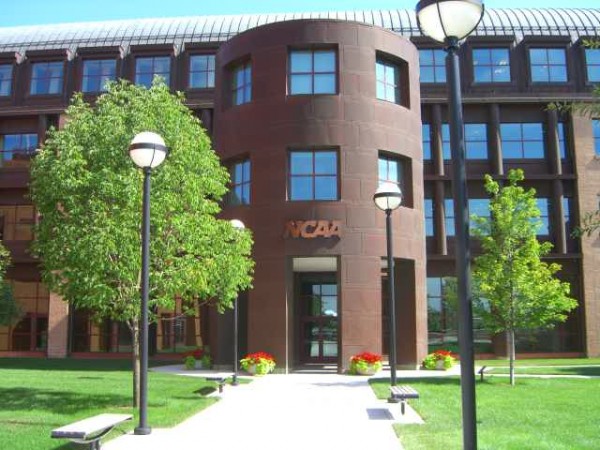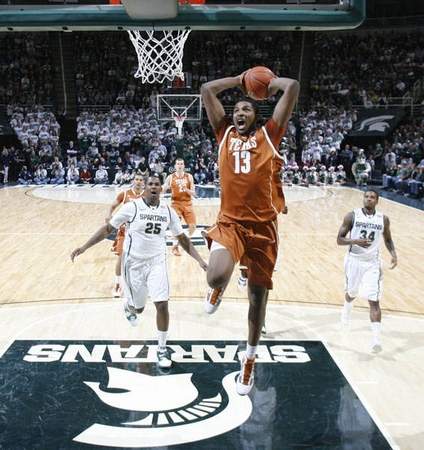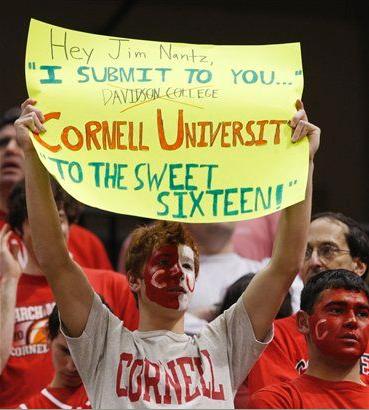Posted by rtmsf on April 23rd, 2010
If you’re like us today, you’re probably feeling a little bit like you do when you realize that the blue lights in your rear view mirror weren’t intended for you even though you were about +15 over the speed limit. As the friendly patrolman roars by on your left, that adrenaline-fueled fear of getting a ticket (or worse) melts into a somewhat euphoric state of well-being as you realize that you’ve dodged a terribly unpleasant situation. We all spent the last two months lying hogtied on the tracks watching the 96-team locomotive steaming toward us, and the surprising (shocking?) news that the NCAA will instead move to only a 68-team scenario feels like Clint Eastwood or Rambo or freakin’ Michael Cera stepped in at the last moment to save the day. Perspective is everything.

NCAA HQ Can Cancel That Security Detail Now
Yet imagine for a moment if we’d never heard about the 96-team debacle from the inner circles of the NCAA. Without that particularly bilious perspective to abhor, excoriate, lambaste and dread for months leading up to today, the news that the NCAA was expanding to 68 teams would probably have been met with complete and utter derision across the board. Four play-in games, pfshaw! Yet when considered against the alternative, today’s news was met with guarded optimism and in some cases downright celebration. Was this a brilliant strategem of managing expectations pulled off on us, the unsuspecting public, by the cunning NCAA (probably not), or simply a realization that the organization was treading ever so closely to killing off the goose that laid the golden egg (more likely)? Either way, the decision is a reasonable and defensible one that we can all live with, so let’s get to the business of reviewing it now and analyzing it to death in coming weeks.
Here’s what some of the best in the business have to say…
Luke Winn, CNNSI – More importantly, it represents a major victory for college basketball. The NCAA did the right thing. While I’d prefer a pure, 64-team format without play-in games, 68 teams is immensely more palatable than 96. The sanctity of the NCAA tournament has been preserved for the time being, and that’s something to celebrate, even if Jim Isch, the NCAA’s interim president, admitted that 68 wasn’t guaranteed to be the format for the entire length of the new TV deal. […] Public reaction had to have played at least some role in them settling on 68 rather than 96. The public’s response to the 96 idea was overwhelmingly negative, and I wonder if Isch, Shaheen, CBS and Turner didn’t want to be regarded as the villains who ruined college sports’ crown jewel. […] Eventually, we’ll get back to worrying about how Isch left the expansion door open by saying two words: “for now.” But for now, at least, we can rejoice. The NCAA tournament has been saved.
Mike DeCourcy, Sporting News – Turns out, they were listening. Nobody came out and said the public’s revulsion at the prospect of a 96-team field was a factor in settling on 68, but if you’d loved the idea like chocolate-chip cookies, we’d be talking about a far different NCAA Tournament next March. It wasn’t at the start of negotiations that someone with CBS/Turner suggested a 68-team tournament would be workable with the dollar amounts being discussed. That came after the general public declared 96 teams to be a product no more appealing than the XFL. […] How should a 68-team tournament work? That’s fairly obvious. Although it might be most fair to have the teams at the bottom of the field play for the right to be No. 16 seeds, it’s hard to imagine anyone at CBS or Turner Sports, the networks that just agreed to pay roughly $740 million annually to televise the tournament, being thrilled about showing four games that this year might have involved such matchups as Robert Morris-Winthrop or Morgan State-East Tennessee State. The solution would be to have the last eightat-large teams play for the right to be seeded into the middle of the field—as No. 12s or No. 11s. This season, that might have meant Virginia Tech-Minnesota and Illinois-Florida. People would watch those games. CBS and Turner saved us from the dread of a 96-team tournament. They deserve something for their money.
Read the rest of this entry »
| randomness
| Tagged: gary parrish, jeff goodman, john gasaway, kyle whelliston, luke winn, mike decourcy, ncaa expansion, pat forde, rob dauster
Share this story














































